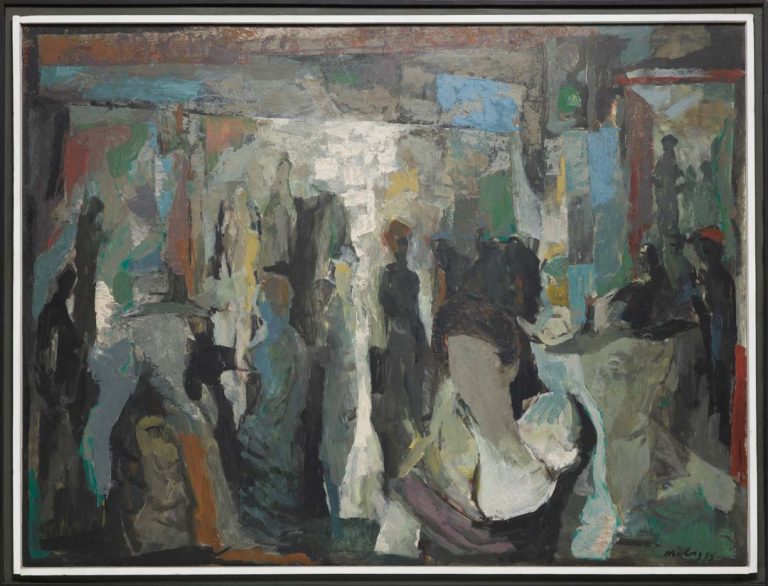We acknowledge the Traditional Owners of the land on which the Queensland Art Gallery | Gallery of Modern Art stands and recognise the creative contribution First Australians make to the art and culture of this country.

Jon Molvig / Australia 1923–70 / Street crossing arrangement 1955 / Oil on composition board / 91.5 x 122.2cm / Purchased (by exchange) 1957 / Collection: Queensland Art Gallery | Gallery of Modern Art / © Otte Bartzis
Jon MolvigStreet crossing arrangement 1955
Not Currently on Display
Jon Molvig moved to Brisbane in 1955 and his new environment inspired a number of works, including Street crossing arrangement. The painting shares some similarities with John Brack’s iconic Melbourne street scene Collins St, 5p.m. (National Gallery of Victoria) painted in the same year, not only in terms of subject matter, but also in the layering of figures.
In Molvig’s painting, a faceless woman — wearing a tight black dress with a low-cut neckline — dominates the foreground and recalls the figures in Willem de Kooning’s (1904–97) ‘Woman’ series of the early 1950s. To the left of the woman, a man in profile to the left faces another female figure, who is seemingly naked from the waist up in the style of the Venus de Milo.
Molvig described this work and others that depicted urban scenes as his ‘satires’.1 In the mid 1950s, Brisbane was still host to a number of brothels that had opened during World War Two, and here Molvig offers a glimpse of the darker side of city life.
Endnotes:
1 Jon Molvig Interviewed by Hazel de Berg in the Hazel de Berg Collection [sound recording], Hazel de Berg Collection, National Library of Australia, Canberra; DeB 15, June 1961, <http://nla.gov.au/nla.obj-214255022>, accessed July 2019.
Jon Molvig was born in Newcastle, Australia, in 1923. After serving in New Guinea and the Philippines during World War Two, Molvig studied art for three years in Sydney, then went on to travel throughout Europe, where he encountered the German and Norwegian expressionists who would significantly influence his work.
From 1955 until his death in 1970, Molvig was based in Brisbane. A complex man, his career was characterised by radical shifts in style. Molvig was also known for his highly considered exploration of technique and the power of his symbolism.
It’s a matter of inventing symbols for what you want to say and putting the symbols down in paint . . . I believe that for every subject you tackle you must invent a new set of symbols and sometimes a new technique to say what you want to say.1 — Jon Molvig
Endnotes:
1 Jon Molvig Interviewed by Hazel de Berg in the Hazel de Berg Collection [sound recording], Hazel de Berg Collection, National Library of Australia, Canberra; DeB 15, June 1961, <http://nla.gov.au/nla.obj-214255022>, accessed July 2019.
Discussion Questions
1. How does Molvig’s application of paint, together with the painting’s composition and tonal qualities, influence your reaction to the work?
2. How does the title contribute to an understanding of the cultural context of the painting?
3. As a satirical painting, what was Molvig’s intention with Street crossing arrangement?
Classroom Activities
Using Street crossing arrangement as inspiration, photograph an urban scene that captures a particular moment in time. Include small clues and symbols that communicate the cultural context, particularly the time and place. Demonstrate how the use of symbols can enhance meaning.